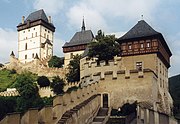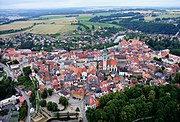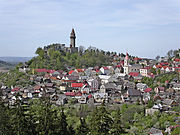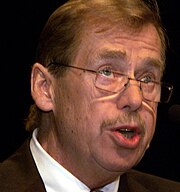The Czech Republic (Template:IPAEng) (Template:Audio-cs, short form in Template:Lang-cs, Template:IPA2), is a landlocked country in Central Europe and a member state of the European Union. The country has borders with Poland to the northeast, Germany to the west, Austria to the south, and Slovakia to the east. The capital and largest city is Prague (Template:Lang-cs), a major tourist destination. The country is composed of the historic regions of Bohemia and Moravia, as well as parts of Silesia.
Following the Battle of the White Mountain, the Czech lands fell under the Habsburg rule from 1526, later becoming part of the Austrian Empire and Austria-Hungary. The independent Republic of Czechoslovakia was formed in 1918, following the collapse of the Austro-Hungarian empire after World War I. After the Munich Agreement, German occupation of Czechoslovakia and the consequent disillusion with the Western response and gratitude for the liberation of the major portion of Czechoslovakia by the Red Army, the Communist party won plurality (38 %)[1] in 1946 elections. In an 1948 overturn, Czechoslovakia became a communist-ruled state. In 1968, the increasing dissatisfaction has culminated in attempts to reform the communist regime. The events, known as Prague Spring of 1968, had ended with a invasion of armies of Warsaw Pact countries, and the troops remained in the country until the overturn in 1989 Velvet Revolution, when the communist regime collapsed. On January 1, 1993 the country Czechoslovakia peacefully split into the Czech Republic and Slovakia.
The Czech Republic made economic reforms such as massive privatization and flat tax. Annual gross domestic product growth has recently been around 6%. The country is the first former member of the Comecon to achieve the status of a developed country (2006) according to the World Bank.[2] The Czech Republic also ranks best compared to the former Comecon countries in the Human Development Index.[3]
The Czech Republic is a pluralist multi-party parliamentary representative democracy. President Václav Klaus is the current head of state. The Prime Minister is the head of government (currently Mirek Topolánek). The Parliament has two chambers — the Chamber of Deputies and the Senate. The Czech Republic joined NATO in 1999 and the European Union in 2004. It is also a member of the OECD, the Council of Europe and the Visegrád Group.
The Czech Republic first participated at the Olympic Games as an independent nation in 1994, and has competed in every Summer Olympic Games and Winter Olympic Games since then. Prior to the dissolution of Czechoslovakia in 1993, Czech athletes had competed at the Olympics from 1920 to 1992 as Czechoslovakia and from 1900 to 1912 as Bohemia.
Athletes from the Czech Republic have won a total of 27 medals at the Summer Games, with canoeing and athletics as the top medal-producing sports. The nation has also won 10 medals at the Winter Games, most notably the gold medal and bronze medal won by the Czech Republic national ice hockey team in 1998 and 2006 respectively.
The National Olympic Committee for the Czech Republic is the Czech Olympic Committee, which was originally founded in 1899 and recognized in its current form by the International Olympic Committee in 1993.
Links[]
Medal tables[]
Template:See also
Medals by Summer Games[]
| 1996 Atlanta | 4 | 3 | 4 | 11 |
| 2000 Sydney | 2 | 3 | 3 | 8 |
| 2004 Athens | 1 | 3 | 4 | 8 |
| Total | 7 | 9 | 11 | 27 |
|---|
Medals by Winter Games[]
| 1994 Lillehammer | 0 | 0 | 0 | 0 |
| 1998 Nagano | 1 | 1 | 1 | 3 |
| 2002 Salt Lake City | 1 | 2 | 0 | 3 |
| 2006 Turin | 1 | 2 | 1 | 4 |
| Total | 3 | 5 | 2 | 10 |
|---|
Medals by summer sport[]
| Canoeing | 4 | 2 | 2 | 8 |
| Athletics | 3 | 1 | 3 | 7 |
| Shooting | 0 | 2 | 3 | 5 |
| Tennis | 0 | 1 | 1 | 2 |
| Boxing | 0 | 1 | 0 | 1 |
| Rowing | 0 | 1 | 0 | 1 |
| Sailing | 0 | 1 | 0 | 1 |
| Modern pentathlon | 0 | 0 | 1 | 1 |
| Triathlon | 0 | 0 | 1 | 1 |
| Total | 7 | 9 | 11 | 27 |
|---|
Medals by winter sport[]
| Cross-country skiing | 1 | 5 | 1 | 7 |
| Ice hockey | 1 | 0 | 1 | 2 |
| Freestyle skiing | 1 | 0 | 0 | 1 |
| Total | 3 | 5 | 2 | 10 |
|---|
Name[]
Template:Seealso After the dissolution of Czechoslovakia, the Czech portion found itself without a common single-word name in English. In 1993, The Czech Ministry of Foreign Affairs suggested the name Czechia as an official alternative in all situations other than formal official documents and the full names of government institutions; however, this has not become widely used--though other languages have single-word names, e.g. Tschechien in German, and Czechy in Polish. The official website of the Czech Republic (www.czech.cz) run by the Czech Ministry of Foreign Affairs does not use the name Czechia as of 2005. Its Czech equivalent is Česko.
History[]

Prague Castle

Karlštejn

Tábor
- Main article: History of Czechoslovakia
Archaeologists have found evidence of prehistoric human settlement in the area dating back to the Neolithic era. In the classical era, from the 3rd century BC Celtic migrations, the Boii (see Bohemia) and later in the 1st century Germanic tribes of Marcomanni and Quadi settled there. During the Migration Period around the 5th century, many Germanic tribes moved westwards and southwards out of Central Europe. In an equally significant migration, Slavic people from the Black Sea and Carpathian regions settled in the area (a movement that was also stimulated by the onslaught of peoples from Siberia and Eastern Europe: Huns, Avars, Bulgars and Magyars). Following in the Germans' wake, they moved southwards into Bohemia, Moravia, and some of present day Austria. During the 7th century the Frankish merchant Samo, supporting the Slavs fighting their Avar rulers, became the ruler of the first known Slav state in Central Europe. The Moravian principality arose in the 8th century (see Great Moravia). The Bohemian or Czech state emerged in the late 9th century when it was unified by the Přemyslid dynasty. The kingdom of Bohemia was a significant regional power during the Middle Ages. It was part of the Holy Roman Empire during the entire existence of this confederation.
Religious conflicts such as the 15th century Hussite Wars and the 17th century Thirty Years' War had a devastating effect on the local population. From the 16th century, Bohemia came increasingly under Habsburg control as the Habsburgs became first the elected and then hereditary rulers of Bohemia. After the fall of the Holy Roman Empire, Bohemia became part of Austrian Empire and later of Austria-Hungary.

Štramberk
Modern era[]
In November 1989, Czechoslovakia returned to democracy through a peaceful "Velvet Revolution". However, Slovak national aspirations strengthened until on January 1 1993, the country peacefully split into the independent Czech Republic and Slovakia. Both countries went through economic reforms and privatisations, with the intention of creating a market economy.
From 1991 the Czech Republic (originally as part of Czechoslovakia, and now in its own right) has been a member of the Visegrad Group and from 1995 of the OECD. The Czech Republic joined NATO on March 12 1999 and the European Union on May 1 2004.
Geography[]

General map of the Czech Republic

Labe near Děčín

Map of the Czech Republic showing cities and main towns

Moravian-Silesian Beskids
- Main article: Geography of the Czech Republic
Template:See also The Czech landscape is quite varied. Bohemia to the west consists of a basin, drained by the Elbe (Template:Lang-cz) and the Vltava rivers, and surrounded by mostly low mountains such as the Krkonoše range of the Sudetes. The highest point in the country, Sněžka, at 1,602 m (5,262 ft), is located here. Moravia, the eastern part of the country, is also quite hilly. It is drained mainly by the Morava River, but it also contains the source of the Oder (Template:Lang-cz) River. Water from the landlocked Czech Republic flows to three different seas: the North Sea, Baltic Sea and Black Sea. The Czech Republic also leases the Moldauhafen, a Template:Convert lot in the middle of the Hamburg Docks, which was awarded to Czechoslovakia by Article 363 of the Treaty of Versailles to allow the landlocked country a place where goods transported downriver could be transferred to seagoing ships. The territory reverts to Germany in 2028.
Phytogeographically, the Czech Republic belongs to the Central European province of the Circumboreal Region within the Boreal Kingdom. According to the WWF, the territory of the Czech Republic can be subdivided into four ecoregions: the Central European mixed forests, Pannonian mixed forests, Western European broadleaf forests and Carpathian montane conifer forests.
Weather and climate[]
The Czech Republic has a temperate, continental climate with relatively hot summers and cold, cloudy winters, usually with snow. Most rains are during the summer. The temperature difference between summers and winters is relatively high due to its landlocked geographical position.
Even within the Czech Republic, temperatures vary greatly depending on the elevation. In general, at higher altitudes the temperatures decrease and precipitation increases. Another important factor is the distribution of the mountains. Therefore the climate is quite varied.
At the highest peak (Sněžka, Template:Convert) the average temperature is only Template:Convert, whereas in the lowlands of South Moravia, the average temperature is as high as Template:Convert. This also applies for the country's capital Prague, but this is due to urban factors.
The coldest month is usually January followed by February and December. During these months there is usually snow in the mountains and sometimes in the major cities and lowlands. During March, April and May, the temperature usually increases rapidly and especially during April the temperature and weather tends to vary widely during the day. Spring is also characterized by high water levels in the rivers due to melting snow followed by floods at times.
The warmest month of the year is July, followed by August and June. On average, the summer temperatures are about Template:Convert higher than during winter. Especially in the last decade,Template:Fact temperatures above Template:Convert are not unusual. Summer is also characterized by rain and storms.
Autumn generally begins in September, which is still relatively warm, but much drier. During October, temperatures usually fall back under 15° or 10°C (59° or 50°F) and deciduous trees begin to shed their leaves. By the end of November, temperatures usually range around the freezing point.
Population[]
| Year | Total | Change | Year | Total | Change |
|---|---|---|---|---|---|
| 1857 | 7,016,531 | — | 1930 | 10,674,386 | 6.6% |
| 1869 | 7,617,230 | 8.6% | 1950 | 8,896,133 | -16.7% |
| 1880 | 8,222,013 | 7.9% | 1961 | 9,571,531 | 7.6% |
| 1890 | 8,665,421 | 5.4% | 1970 | 9,807,697 | 2.5% |
| 1900 | 9,372,214 | 8.2% | 1980 | 10,291,927 | 4.9% |
| 1910 | 10,078,637 | 7.5% | 1991 | 10,302,215 | 0.1% |
| 1921 | 10,009,587 | -0.7% | 2001 | 10,230,060 | -0.7% |
The vast majority of the inhabitants of the Czech Republic are Czechs (94.2%). Minorities include the Slovaks (1.9%), Poles (0.5%), Vietnamese (0.44%)Template:Fact Germans (0.4%)[5]. According to the Interior Ministry of the Czech Republic, there were 392,087 foreigners legally residing in the country at the end of 2007, making up 3.2% of the population, with the largest groups being Ukrainians and Slovaks[6].
Fertility rate was low at 1.44 children born/woman. In 2007, immigration added to the population by almost 1%.
Religion[]
The Czech Republic, along with Estonia, has one of the least religious populations in all of Europe. According to the 2001 census, 59% of the country is agnostic, atheist, non-believer or no-organised believer, 26.8% Roman Catholic and 2.5% Protestant.[7]
According to the most recent Eurobarometer Poll 2005,[8] 19% of Czech citizens responded that "they believe there is a God", whereas 50% answered that "they believe there is some sort of spirit or life force" and 30% that "they do not believe there is any sort of spirit, God, or life force", the lowest rate of EU countries after Estonia with 16%.[9]
Politics[]

Václav Havel, the first President of the Czech Republic.

Václav Klaus, current President of the Czech Republic.
- Main article: Politics of the Czech Republic
Political system[]
The Czech Republic is a pluralist multi-party parliamentary representative democracy, where the Prime Minister is the head of government. The Parliament is bicameral, with the Chamber of Deputies (Template:Lang-cs) (200 members) and the Senate (81 members).
Foreign policy[]
A key goal in foreign policy has been European integration.
According to The Economist, the Czech Republic has earned a reputation for promoting human rights at every turn. Czech officials have pushed Europe's weight behind democrats everywhere from Myanmar to Belarus, Moldova and Cuba. The Czech foreign ministry has an entire unit devoted to helping dissidents in other countries.[10]
Czech Republic is motivated by its experience of Nazi and communist oppression. Also, the country's first post-communist president Václav Havel is an ex-dissident writer, who has set moral example and has attracted ex-dissidents to key government positions.[10] For example, every March since 2003, when Fidel Castro locked up 75 political opponents, activists have set up a cage in Wenceslas Square representing a Cuban prison cell. Frequent prison uniform-wearing protesters have included names such as the foreign minister, the mayor of Prague and musical stars.[10] Some EU officials have been irritated by Czech Republic's activism in human rights. Czech Republic and other countries stressing human rights have been in conflicts with EU countries who favor closer ties with dictatorships.[10]
Armed forces[]
- Main article: Military of the Czech Republic
The Czech armed forces consist of the Army and Air Force and of specialized support units. In 2004, the Czech armed forces completely phased out conscription and transformed into a fully professional army and air force. The country has been a member of NATO since March 12 1999. Defence spending is around 1.8% of GDP (2006).
Economy[]
- Main article: Economy of the Czech Republic
The Czech Republic possesses a developed,[11] high-income[12] economy with a GDP per capita of 82% of the European Union average. One of the most stable and prosperous of the post-Communist states, the Czech Republic has seen a growth of over 6% annually in the last three years. Recent growth has been led by exports to the European Union, especially Germany, and foreign investment, while domestic demand is reviving. However, the rate of corruption remains one of the highest among OECD countries.
The public budgets remain in deficit despite strong growth of the economy in recent years. However, the 2007 deficit has been 1.58% GDP (according to EU accounting rules), far less than originally expected.
Most of the economy has been privatized, including banks and telecommunications. The current right-center government plans to continue with privatization, including the energy industry and the Prague airport. It has recently agreed to the sale of a 7% stake of the energy producer ČEZ, with the sale of the Budějovický Budvar brewery also mooted.
The country has fully implemented the Schengen Agreement and therefore has abolished border controls with all of its neighbours (Germany, Austria, Poland, Slovakia) on December 21 2007.[13] The Czech Republic is a member of the WTO.
The last Czech government had expressed a desire to adopt the euro in 2010, but the current government has postponed it due to budget deficits. An exact date has not been set up, but the Finance Ministry described adoption by 2012 as realistic[14] if public finance reform passes. However, the most recent draft of the euro adoption plan omits giving any date.
Education[]
The Programme for International Student Assessment, coordinated by the OECD, currently ranks the Czech education as the 15th best in the world, being higher than the OECD average.[15]
Transport[]
Prague Airport is the main international airport. Czech Republic has 46 airports, out of which two have over 3,047 meter runaways.
Tourism[]

Tourists in Prague.

Sněžka is the highest point in the Czech Republic.
- Main article: Tourism in the Czech Republic
The Czech economy gets a substantial income from tourism: in 2001, the total earnings from tourism reached 118.13 billion CZK, making up 5.5% of GNP and 9.3% of overall export earnings. The industry employs more than 110,000 people - over 1% of the population.[16]
There are several centres of tourist activity: The historic city of Prague is the primary tourist attraction, and the city is also the most common point of entry for tourists visiting other parts of the country.[17] Most other cities in the country attract significant numbers of tourists, but the spa towns such as Karlovy Vary, Mariánské Lázně and Františkovy Lázně are particularly popular holiday destinations. Other popular tourist sites are the many castles and chateaux, such as those at Karlštejn, Konopiště and Český Krumlov. Away from the towns, areas as Český ráj, Šumava and the Krkonoše Mountains attract visitors seeking outdoor pursuits.
The country is also famous for its love of puppetry and marionettes. The Pilsner style beer originated in western Bohemian city of Plzeň.
Culture[]
Cuisine[]
Template:Seealso

Vepřo-knedlo-zelo (Roast pork with dumplings and cabbage)
Czech cuisine is marked by a strong emphasis on meat dishes. Pork is quite common, and beef and chicken are also popular. In the last years with the incoming immigrants, Kebab is a popular food of Czech Cuisine as well. Goose, duck, rabbit and wild game are served. Fish is rare, with the occasional exception of fresh trout, and carp, which is served at Christmas.
Aside from Slivovitz, Czech beer and wine, Czechs also produce two uniquely Czech liquors, Fernet Stock and Becherovka. Kofola is a non-alcoholic Czech soft drink somewhat similar in look and taste to Coca-Cola.
Sport[]
- Main article: Sport in the Czech Republic
Template:Seealso Sport plays a significant part in the life of many Czechs who are generally loyal supporters of their favourite teams or individuals. The two leading sports in the Czech Republic are football and ice hockey, both drawing the largest attention of both the media and supporters. The many other sports with professional leagues and structures include basketball, volleyball, handball, athletics, floorball and others. Sport is a source of strong waves of patriotism, usually rising several days or weeks before an event and sinking several days after. The events considered the most important by Czech fans are: the Ice Hockey World Championship, Olympic Ice hockey tournament, the Euro, the football World Cup and qualification matches for such events. In general, any international match of the Czech ice hockey or football national team draws attention, especially when played against a traditional rival: Germany in football; Russia, Sweden and Canada in ice hockey; and Slovakia in both.
- ↑ http://www.libri.cz/databaze/dejiny/text/t98.html (in Czech)
- ↑ Template:Cite web
- ↑ Statistics of the Human Development Report.
- ↑ Czech Statistic Office
- ↑ Template:Cite web
- ↑ Largest number of children since 1993 born in CzechRep last year, Czech.cz, March 20, 2008
- ↑ Template:Cite web
- ↑ Template:Cite web
- ↑ Template:Cite web
- ↑ 10.0 10.1 10.2 10.3 The Economist: Czechs with few mates
- ↑ Getting to know Czech Republic, from Czech.cz, the official site of the Czech Republic
- ↑ World Bank 2007
- ↑ Template:Cite web
- ↑ Template:Cite web
- ↑ OECD.org
- ↑ Template:Cite web
- ↑ Template:Cite web
